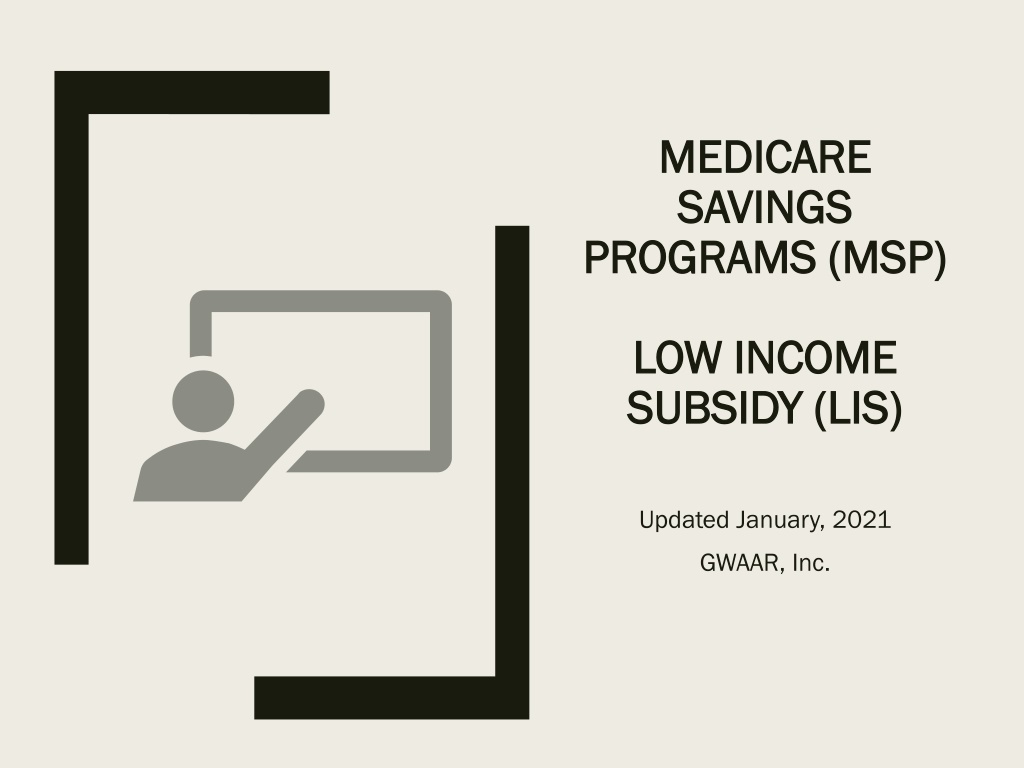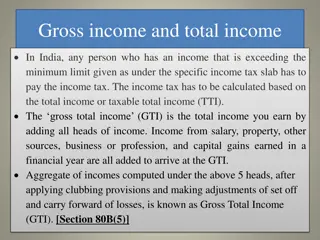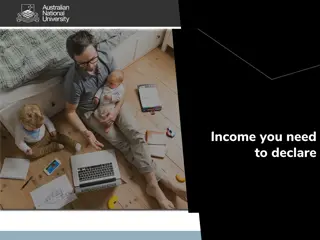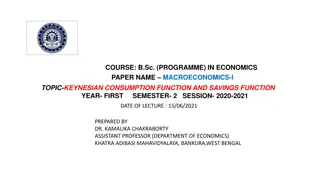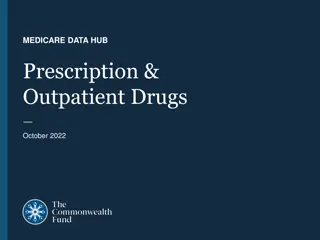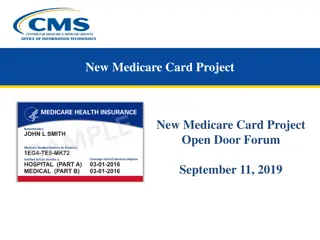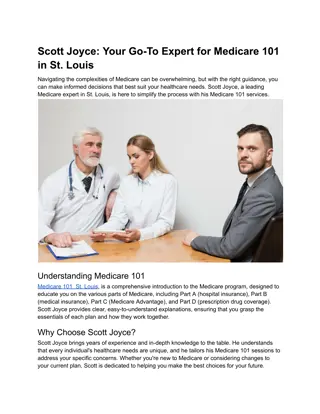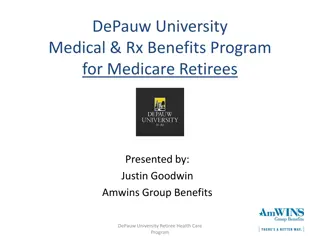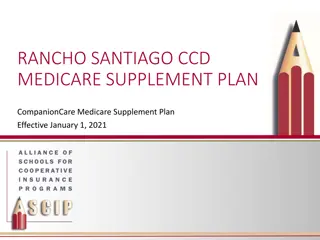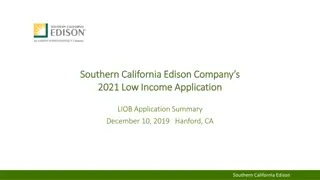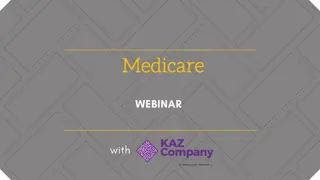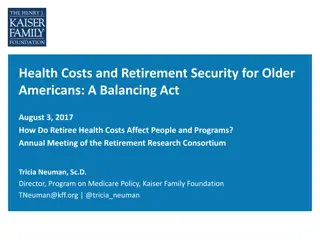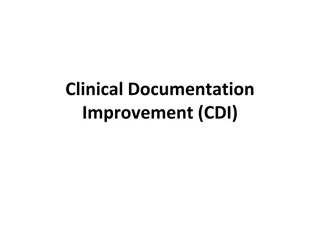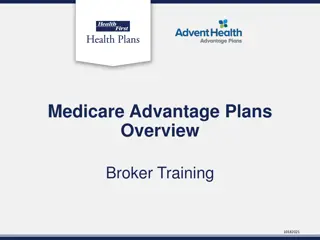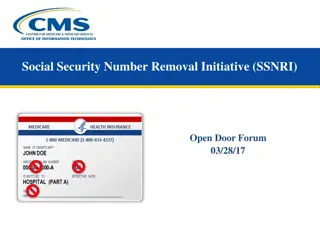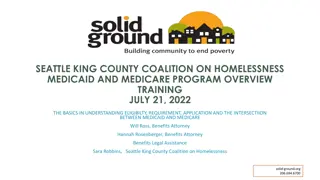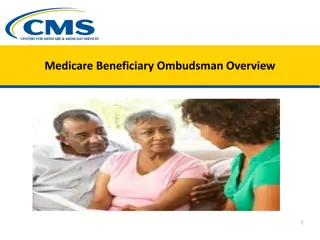Understanding Medicare Savings Programs (MSP) and Low-Income Subsidy (LIS)
Explore how MSPs and LIS are connected to Medicare, Medicaid, and Social Security. Learn about the benefits of MSPs and LIS, identifying clients who may benefit from them. Understand concepts like MSP backdating, LIS enrollment types, deeming rules, and continuing eligibility. Discover where to find relevant information and the benefits provided by different MSP categories. General eligibility requirements for MSPs are also outlined.
Download Presentation

Please find below an Image/Link to download the presentation.
The content on the website is provided AS IS for your information and personal use only. It may not be sold, licensed, or shared on other websites without obtaining consent from the author. Download presentation by click this link. If you encounter any issues during the download, it is possible that the publisher has removed the file from their server.
E N D
Presentation Transcript
MEDICARE MEDICARE SAVINGS SAVINGS PROGRAMS (MSP) PROGRAMS (MSP) LOW INCOME LOW INCOME SUBSIDY (LIS) SUBSIDY (LIS) Updated January, 2021 GWAAR, Inc.
Objectives Understand how MSPs and LIS relate to Medicare, Medicaid, and Social Security Be able to explain the benefits of MSPs and LIS Be able to recognize clients who may benefit from MSPs or LIS Understand the concepts of MSP backdating; LIS automatic vs. facilitated enrollment; and LIS deeming and continuing eligibility Know where to obtain information
MSP and MSP MSP Medicare Savings Programs Wisconsin Medicaid subprograms pay for some or all of a beneficiary s Medicare coinsurance, deductibles, and monthly premiums LIS What Are They? LIS LIS Low-Income Subsidy, or Extra Help Medicare program helps beneficiaries pay for prescription drugs
MEDICARE SAVINGS PROGRAMS (MSP) QMB SLMB SLMB+ QDWI
Medicare Savings Programs QMB QMB (Qualified Medicare Beneficiary) SLMB SLMB (Specified Low-Income Medicare Beneficiary) SLMB+ SLMB+ (Specified Low-Income Medicare Beneficiary Plus) QDWI QDWI (Qualified Disabled and Working Individual)
What Benefits Do They Provide? QMB: QMB: Pays Medicare Part A and B premiums, and all Medicare Parts A & B copays and deductibles SLMB: SLMB: Pays the Medicare Part B premium SLMB+: SLMB+: Pays the Medicare Part B premium QDWI: QDWI: Pays the Medicare Part A premium Note: Note: MSPs also automatically provide beneficiaries with the full Low-Income Subsidy (more on this later)
General Eligibility Requirements All MSPs All MSPs Non-financially eligible for Wisconsin Medicaid or BadgerCare Plus Elderly (Age 65+), Blind, or Disabled Resident of Wisconsin; and U.S. Citizen or a non-citizen who meets certain criteria
General Eligibility Requirements All MSPs All MSPs Entitled to receive, or actually receiving Medicare Part A Receive income at, or below, the income limits Own assets at, or below, the asset limits
Automatic Automatic QMB Eligibility Some Some Medicaid Medicaid recipients are automatically eligible recipients are automatically eligible for QMB for QMB Medicaid + Medicaid + Persons who are receiving or are eligible to receive Supplemental Security Income (SSI) Special Status Medicaid (MEH 25)
Fiscal Test Groups The fiscal test fiscal test group group size determines the income and asset limits The fiscal test group is two couple is married and living at home two if a The fiscal test group is one the couple is not living together or if the couple is living in the same nursing home one if
QMB 2020 QMB 2020 QMB Income Income Limit Limit 100% of the federal poverty level (FPL) Individual: $1,063.33/mo Couple: $1,436.67/mo Income and Asset Limits 2021 QMB 2021 QMB Asset Asset Limit: Individual: $7,970 Couple: $11,960 Limit:
SLMB Income and Asset Limits 2020 SLMB 2020 SLMB Income Income Limit Limit Between 100% and 120% of the FPL Individual: $1,249.00/mo Couple: $1,691.00/mo 2021 SLMB 2021 SLMB Asset Individual: $7,970 Couple: $11,960 Asset Limit: Limit:
SLMB+ Income and Asset Limits 2020 SLMB+ 2020 SLMB+ Income Income Limit Limit Between 120% and 135% of the FPL Individual: $1,435.50/mo Couple: $1,939.50/mo 2021 SLMB+ 2021 SLMB+ Asset Individual: $7,970 Couple: $11,960 Asset Limit: Limit:
How Is Income Income Counted? Income Income calculated the same as SSI 1. Separate earned and unearned income 2. Apply Earned Income Calculation Subtract the $65 and earned income deduction from the total earned income Add the result to the unearned income 3. Subtract Special Exempt Income 4. Subtract the $20 Disregard
How Are Assets Assets Treated? Similar to SSI Similar to SSI Countable assets include: Money in checking or savings accounts Stocks Bonds
How Are Assets Assets Treated? Countable assets Countable assets do not include: include: Personal residence One motor vehicle Burial plot Up to $1,500 in burial expenses if money is put aside Furniture and household items do not
When Do Benefits Begin? (QMB) Applications Applications For initial applications, QMB benefits begin on the first of the month after the month in which the beneficiary is determined eligible Example: Example: Joe applies for QMB on April 16, 2021 and is approved. His QMB benefits will begin May 1, 2021.
When Do Benefits Begin? (QMB) Recertifications Recertifications QMB benefits begin on the first of the month following the month the review is due Example: Example: Mary s QMB benefits are up for review in June 2021. Even if the review is approved on July 1, 2021, QMB benefits begin on July 1, 2021 - not August 1, 2021. There is no disruption in benefits.
When Do Benefits Begin? (SLMB, SLMB+ and QDWI) Benefits begin on the first of the month in which all eligibility requirements are met. Example: Example: Joan applies for MSP benefits on May 21, 2021 and is approved for SLMB on May 27, 2021. Her SLMB benefits will begin on May 1, 2021.
Timing Timing of Benefits It will take 2-3 months for SSA to process the MSP eligibility information. The beneficiary will still need to pay his or her Part B premiums while waiting for SSA to update the beneficiary s information.
Timing Timing of Benefits After information is processed, the beneficiary will receive 2-3 months of Part B premiums as a reimbursement for the period spent waiting. Careful! Careful! The opposite is also true. If an individual is deemed ineligible, it may take 2-3 months to process the termination. Once the termination is processed, SSA will deduct 2-3 months worth of Part B premiums at once. This can cause clients serious financial difficulties
Backdating Backdating Eligibility QMB QMB Cannot normally be backdated unless The eligibility process was not completed in 30 days; Certification of eligibility was not completed; or A Fair Hearing decision orders backdating. unless: SLMB/SLMB+/QDWI SLMB/SLMB+/QDWI Can be backdated up to three months prior to the month of application The individual must have been eligible for all periods of backdating.
Backdating Backdating Eligibility Note : Note : If an individual would have been eligible for QMB during the backdating period, he or she cannot receive backdated SLMB, SLMB+, or QDWI benefits. Example: Example: Molly applies for QMB and backdated SLMB benefits on March 2, 2021. A review of her income shows she would have been eligible for QMB in February, 2021. Because she would have been eligible for QMB during the backdated period, her request for backdated SLMB benefits will be denied.
Medicare Part B Buy In In Buy- - If an individual does not already have Medicare Part B, but is approved for MSP benefits, Wisconsin will buy in that individual into Medicare Part B. This can be very useful if the individual was facing a Medicare Part B late enrollment penalty. This program will pay late enrollment fees while the person is eligible for the MSP. Wisconsin has a Medicare Buy-In Analyst who is very helpful in these situations.
County or IM consortia Use the Medicaid paper application Medicare Savings Programs ACCESS.gov Staff are supposed to screen all applicants for MSPs, but it is not always done How To Apply? The CARES system does give an alert when SSA provides information re: extra help to the State, triggering a screen for MSP.
Treatment Of Extra Help Data Extra Help Data Received From SSA Received From SSA The state receives information from Social Security regarding all LIS applications who didn t opt out. It is required to treat these individuals as applicants for MSPs. The state will mail all of these individuals an EBD Medicaid application and asks them to fill it out. Applications are not complete until the state receives the EBD Medicaid applications. Application date Application date is the date that the state received the extra help information from Social Security.
Medicare Savings Programs: Knowledge Check George, 72, a single man who is receiving Medicare comes to your office and explains he is having difficulty paying his bills each month. He explains that he earns $200 per month doing handyman work for a local business and he also receives $920 per month in Social Security Retirement income. He further explains that he owns his own home, does not have a car and has $5,900 in a checking account at the bank that he uses to pay his bills. Will George be eligible for a Medicare Will George be eligible for a Medicare Savings Program? If so, which one? Savings Program? If so, which one?
THE LOW INCOME THE LOW INCOME SUBSIDY (LIS) SUBSIDY (LIS) AKA: Extra Help
Low A Medicare program that helps beneficiaries pay for prescription drugs Income Subsidy A person with a subsidy has lower Part D costs than a person without a subsidy. The Part D coverage is subsidized.
No donut hole No donut hole Low to $0 premiums Low to $0 premiums LIS Benefits Quarterly* Special Quarterly* Special Enrollment Periods (SEPs) Enrollment Periods (SEPs) No late enrollment No late enrollment penalties (LEPs) penalties (LEPs) * * But no SEPs the last quarter of the year (Oct. Dec.)
Four Ways to Get LIS Four Ways to Get LIS 1. 1. Apply Apply through SSA 2. Automatically if dual eligible (Medicare and Medicaid) 3. Automatically if on a MSP (Medicare Savings Program) 4. Automatically if receiving SSI
Two Types of LIS Benefits Full Benefit Partial Benefit
Full Full Benefit LIS A beneficiary will receive the Full LIS A beneficiary will receive the Full LIS Benefit if Benefit if The beneficiary applies And has annual income below 135% of the FPL And has Resources that do not exceed program limits The beneficiary is automatically eligible based on Full-benefit dual eligible or An SSI recipient or An MSP recipient
Partial Partial Benefit LIS An individual receives the partial subsidy if he or she applies and: Has an annual income below 150% of the FPL; and Resources that do not exceed program limits partial
Full Full Subsidy 2021 Individual: $7,970 Married Couple: $11,960 Partial Partial Subsidy 2021 Individual: $13,290 Married Couple: $26,520 Resource Resource Limits Partial Subsidy applies different resource amounts to determine premium discounts see updated Nutshell Nutshell see updated Burial Exclusion Burial Exclusion Each individual may also own up to $1,500 in a burial exclusion.
Co-Pays Full Benefit LIS 2021 Full Full Subsidy Initial Coverage Period Income below 100% FPL and dual eligible No deductible $1.30 for generics $4.00 for name brand drugs Income between 100% and 135% FPL No deductible $3.70 for generics $9.20 for name brand drugs
Co-Pays Full Benefit LIS There is no Coverage Gap Catastrophic Period $0 co-pays for both generic and name brand drugs Note: Note: Full benefit dual eligible who are institutionalized or who are enrolled in a home and community based waiver program at a nursing home level of care have $0 co-pays at all times ** Dual eligibility, MSP eligibility, and NH Medicaid, IRIS< FamilyCare, or Partnership eligibility must also be factored see updated Nutshell
Co-Pays Partial Benefit LIS 2021 Partial Partial Subsidy Initial Coverage Period Income between 135% and 150% FPL $92 deductible 15% co-payments after deductible is met There is no Coverage Gap Catastrophic Period $3.70 for generics $9.20 for name brand drugs
Premium Discounts Full Full Subsidy $0 premiums for low-cost or benchmark plans. Partial Partial Subsidy** Income between 146%-150% FPL 25% discount Income between 141%-145% FPL 50% discount Income between 136%-140% FPL 75% discount Income 135% FPL, or less 100% discount ** Partial Subsidy applies different resource amounts to determine premium discounts see updated Nutshell
Low Cost or Benchmark Plans To maximize savings with a subsidy, a LIS beneficiary must be in one of these plans. A low cost plan, sometimes called a benchmark plan plan, is one with a premium that falls below the benchmark dollar figure for your state and is a basic not enhanced plan. benchmark Full subsidy individuals have no premium in one of these plans. The benchmark premium amount in WI in 2021 is $40.70
Timing of Benefits Dual Eligibles Special Rules Special Rules Dual eligibles who have not elected a Part D plan are auto-enrolled into a low-cost plan prospectively Effective date of auto-enrollment is 1st day of 2nd month after CMS identifies individual must affirmatively opt out of auto- enrollment enrollment for dual eligibles is retroactive to 1st day of Medicaid eligibility beneficiary is enrolled in LINET to cover retroactive date through start date of LIS NOTE: NOTE: only dual eligibles can receive retroactive LINET coverage
CAREFUL! Dual Eligibles with Advantage Plans If someone already has a Medicare Advantage Plan WITHOUT drug coverage: Must either Retroactively enroll in from the Advantage Plan w/Rx; OR Retroactively disenroll from the Advantage Plan and retroactively enroll in the stand-alone Part D Plan *Contact your Program Attorney!
Timing of Benefits Dual Eligibles Example: Example: Lydia, a Medicare recipient, becomes eligible for Medicaid on June 1, 2021 and CMS identifies her as eligible for LIS on July 1, 2021. Her Part D plan effective date is September 1, 2021. As a dual eligible, Lydia can receive LINET coverage from June 1, 2021 through September 1, 2021.
LINET LINET Limited Income Newly Eligible Transition program Temporary, comprehensive coverage to fill the gaps when beneficiaries are waiting for their enrollment Take Best Available Evidence (BAE) to the pharmacy proof of Medicaid and Medicare eligibility Take Four Steps for Pharmacy Providers so pharmacy understands process of using LINET http://apps.humana.com/marketing/documents.asp?fil e=2066961
CAREFUL! When LINET Won t Work 1. Client already has a Part D Plan 2. Client opted out of auto-enrollment 3. Has an Advantage plan without drug coverage 4. Has employer or retiree sponsored drug coverage
All other non-dual eligibles are automatically enrolled into a low cost plan, unless the beneficiary affirmatively opts out of auto-enrollment Timing of Benefits benefits begin the 1st day of the 2nd month after CMS identifies the individual as eligible All other LIS beneficiaries LINET is available prospectively until enrollment becomes effective (Non-dual eligibles) Beneficiaries may be able to get reimbursed for some of the time they were eligible for LIS but not yet in the plan
Timing of Benefits All other LIS beneficiaries (Non-dual eligibles) Example: Example: CMS receives notice that Leonard is eligible for LIS in July, 2021. Leonard s enrollment into a LIS plan will be effective September 1, 2021. Leonard can get prospective LINET coverage from July-September, 2021.
Effective dates of LIS when already in a Part D plan Cost sharing will go back to when LIS status was established. May be entitled to a refund in premiums or copays
LIS Special Enrollment Periods (SEPs) LIS recipients have the ability ability to change plans each month quarterly*. The new plan choice will be effective on the first day of the month following enrollment. * But no SEP the last quarter of the year (Oct. Dec.)
